 Technology peripherals
Technology peripherals
 AI
AI
 Say goodbye to design software to generate renderings in one sentence, generative AI subverts the field of decoration and decoration, with 28 popular tools
Say goodbye to design software to generate renderings in one sentence, generative AI subverts the field of decoration and decoration, with 28 popular tools
Say goodbye to design software to generate renderings in one sentence, generative AI subverts the field of decoration and decoration, with 28 popular tools
▲ This picture is generated by AI
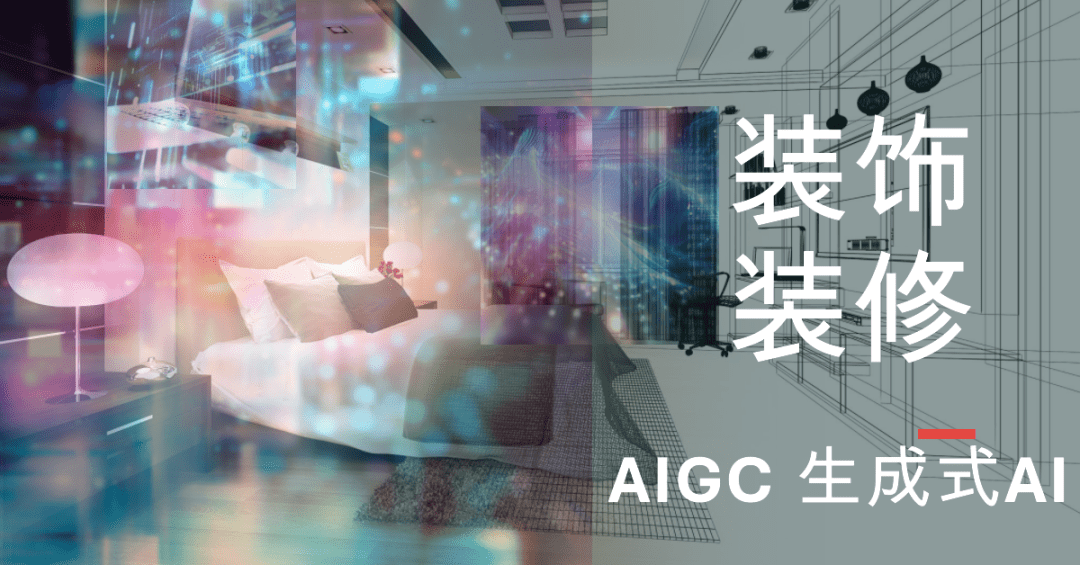
Kujiale, Sanweijia, Dongyi Risheng, etc. have already taken action, and the decoration industry chain has introduced AIGC in a large scale
What are the applications of generative AI in the field of decoration and decoration? What impact does it have on designers? One article to understand
Say goodbye to various design software to generate renderings in one sentence, generative AI is subverting the field of decoration
Use artificial intelligence to enhance capabilities to improve design efficiency, and generative AI transforms the decoration industry
What impact does generative AI have on the decoration and decoration industry? What are the future development trends? One article to understand
LLM revolutionizes decoration and decoration, these 28 popular generative AI decoration design tools are worth trying out
Text/Wang Jiwei
In the field of decoration and decoration, there has been a lot of news related to AIGC recently.
Collov has launched CollovGPT 0.2, a generative AI-driven design tool that enables users to try out various design styles and a one-stop furniture purchasing solution.
Planner 5D has also launched a design tool Design Generator based on Stable Diffusion, which can quickly generate customized interior design renderings by simply uploading images.
With foreign manufacturers taking the lead, and with AIGC sweeping across all walks of life, relevant domestic manufacturers have also released generative AI products or strategies.
Kujiale established an AIGC laboratory, Sanweijia strategically cooperated with Unbounded AI, Shangpin Zhaipei released AIGC technology based on multi-modal large models, and Dongyi Risheng released three new paradigm AIGC home improvement tools in one go.
In addition, there are also decorative design generative AI applications such as Shencai for decoration, and Wenshengtu applications such as Wujie AI and Chenyu AI can also generate decorative renderings themselves.
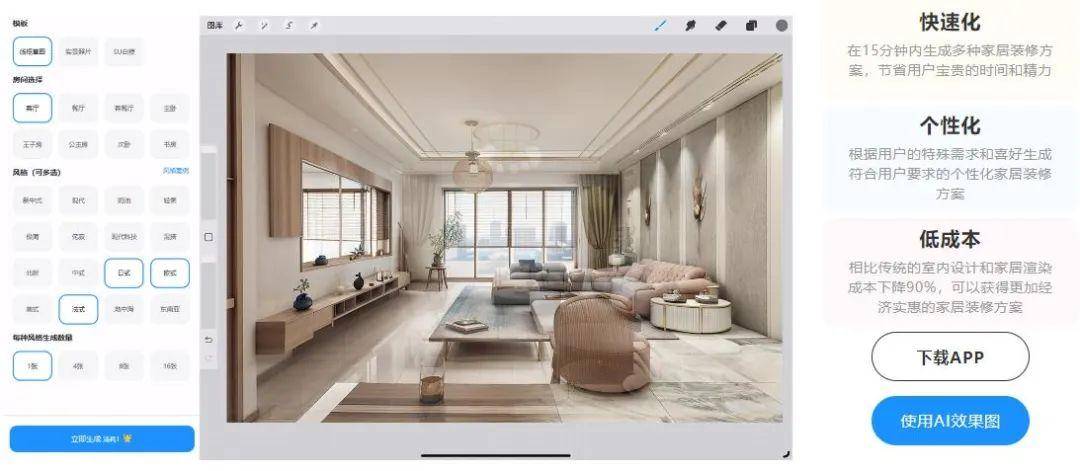
Have you noticed that it seems that all manufacturers in the decoration industry chain can release AIGC design tools, and all AI drawing tools can generate decorative renderings.
As long as you are interested, regardless of whether you have learned software such as AutoCAD or 3DMAX, as long as you can type, you can use these AI drawing tools to easily get the decorative renderings you need.
It seems that overnight, there is nothing left for designers to do when it comes to rendering renderings.
A simple logic is that if everyone can generate decoration renderings by themselves, and if decoration companies are using generative AI to generate decoration renderings, do they still need so many designers?
As a result, a wave of anxiety has invaded the country’s army of 3 million interior designers. Some designers don’t care about generative AI design tools. They believe that AI cannot completely replace humans.
Previously, a big original artist in the gaming industry had a similar view. He set a flag and believed that AI would not replace soulful designers, and ended up being laid off sadly.
Of course this may be a joke, but it still shows the living conditions of the original painting designer in an exaggerated way.
The original painting designer is like this, what about the interior decoration designer?
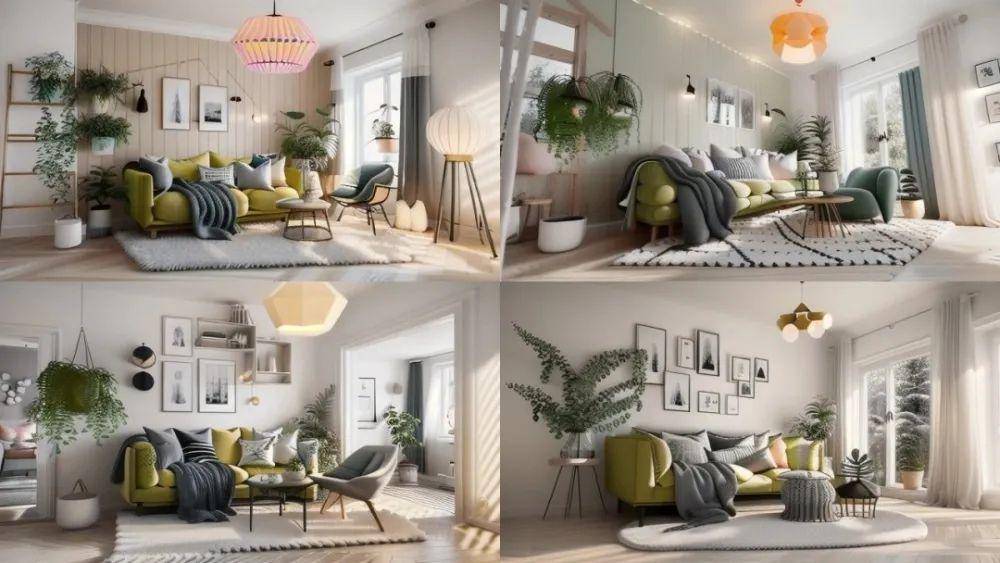
Therefore, there are still some designers who are anxious and worried and have first come into contact with generative AI. They began to use generative AI tools to assist design and drawing, optimize workflow, and improve work efficiency.
As a result, you can now see that many designer bloggers on video platforms such as Douyin, Xiaohongshu, and Bilibili have begun to help fans design decoration drawings for free, or teach everyone how to use AI tools to design decoration drawings.
Generative AI has deeply affected decoration and decoration, and its use can greatly improve design efficiency. This means that the sooner you come into contact with and use it, the more efficient and convenient it can bring, and you can even share some dividends.
So, what impact does generative AI have on the decoration industry? What are the application scenarios of generative AI in the field of decoration and decoration? What are the future development trends? Will it completely replace human designers?
In this article, Wang Jiwei Channel will talk to you about these.
When decoration meets generative AI
Now on any video platform, as long as you enter the two keywords AIGC and decoration, you can find a large number of videos on the software introduction, usage teaching and rendering display of using generative AI software applications to create decoration drawings.
Especially on platforms such as Xiaohongshu and Douyin, if you enter "home decoration design AIGC", you can search for a large number of beautiful home decoration pictures designed by AIGC. Moreover, there are many designer bloggers who can draw pictures for users at low cost, and some even provide home decoration design plans for free. You only need to provide a live image and style requirements, and they can provide multiple renderings in minutes.
Since the main focus is on AIGC to produce decoration drawings, behind this, of course, generative AI software is used to generate various drawings.
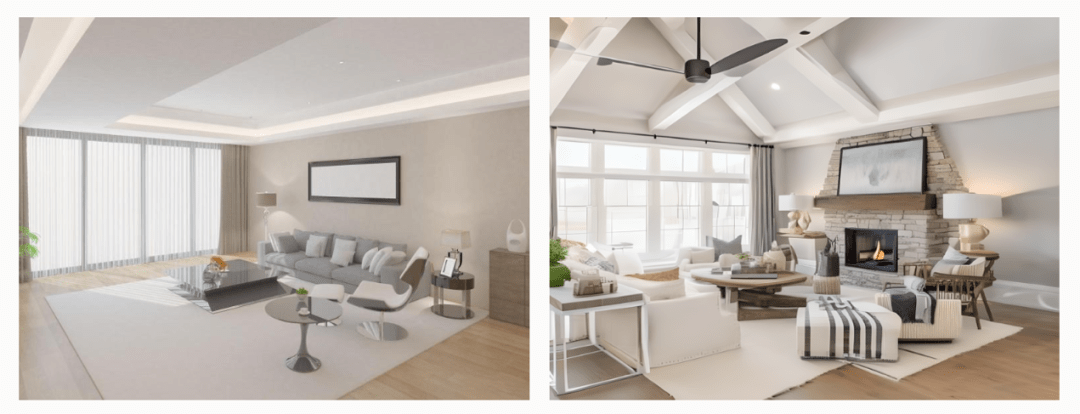
After the trend of AIGC blew up, the decoration field began to actively try to use various software to generate decoration drawings. At present, mainstream AI drawing software such as Midjourney, Stable Diffusion (SD), etc. can easily generate decorative renderings.
At the same time, there are many generative AI applications for decoration based on large language models such as ChatGPT, Midjourney, and SD that are also springing up.
Now to make an interior decoration rendering, you only need to select a specific area, enter prompt words such as style and shape, AI painting will draw multiple pictures with one click, and then select the one that is consistent with the style of the entire house. .
The emergence of large language models allows people without any design experience to generate the desired decoration drawings through natural language descriptions and a few sentences. They no longer need to learn and use complex design software from plane to 3D. It greatly improves the efficiency of drawing decoration drawings, which has never happened before.
Generative AI is an artificial intelligence method that uses machine learning and deep learning technology to automatically generate new content or samples based on given data or conditions. In the field of interior decoration design, generative AI can help designers and users achieve more efficient, smarter, and more personalized design solutions and experiences.

Compared with traditional interior decoration design methods, generative AI can do the following:
Based on the user's needs, preferences and budget, it automatically provides design solutions in a variety of styles and layouts, allowing users to quickly select and compare, saving time and costs. It can also adjust and optimize the design plan in real time based on user feedback to improve user satisfaction.
Using virtual reality and augmented reality technology, users can preview and experience design effects in a digital environment, enhancing immersion and reality. Users can freely move, observe and interact in the virtual space, feel the effects of different lights, colors, materials and furniture, and improve the visualization and communication effects of the design.
By analyzing a large amount of data and cases, we learn and discover the rules and patterns in interior decoration design, and provide more intelligent and innovative design suggestions. It can also be combined with smart home systems to achieve more intelligent and convenient indoor control and management, such as intelligent lighting adjustment, intelligent curtain control, etc., providing users with a more comfortable and safer indoor environment.
Overall, generative AI can effectively improve the efficiency and quality of design, and can bring a more intelligent and personalized design experience.
AIGC attempt in the decoration industry chain
There are Midjourney and SD in the front, and ChatGPT and AutoGPT in the back. After the hurricane of AIGC hit the decoration field, almost all companies that were concerned about and sensitive to technology quickly took action to explore the impact of existing generative AI on the decoration industry and introduced this technology into their own technical architecture. Create new generative design software and tools.
ChatGPT was launched in November last year. In more than half a year now, more and more generative AI applications for decoration and design have appeared from overseas to China, and their functions have become more and more complete.
Collov, an online design solutions provider, has launched the generative AI-driven design tool CollovGPT 0.2, allowing users to try out various design styles and a one-stop furniture purchasing solution. This tool is based on Stable Diffusion (Stable Diffusion) and GNN (Graphic Neural Network) technologies to provide users with a seamless user experience, maximize rendering time savings in seconds, and provide users with a high-quality design process.
Electronic design business platform Planner 5D has launched a generative AI tool called Design Generator. This tool is based on a combination of the stable diffusion AI model and the Planner 5D algorithm. User-uploaded images can quickly generate customized interior design renderings. picture.
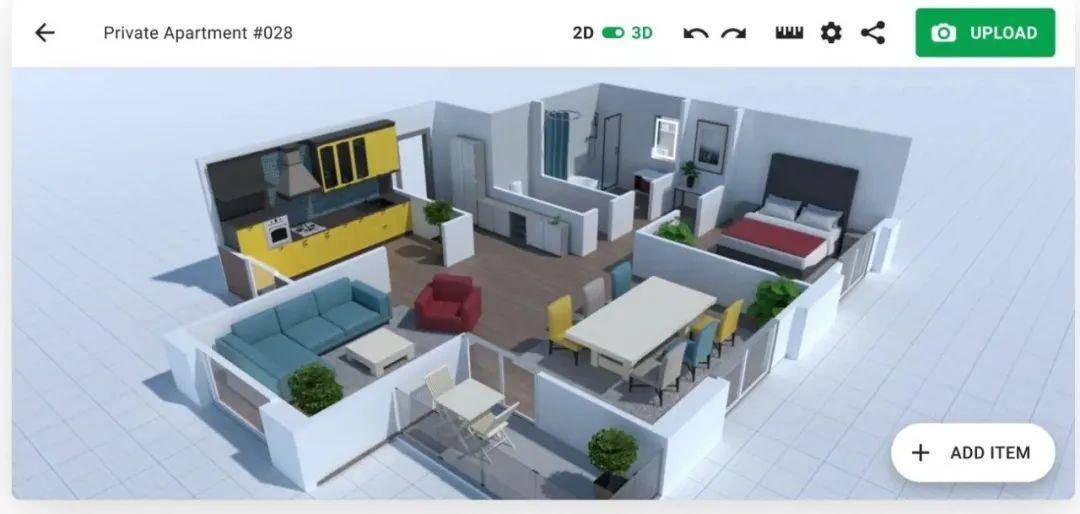
Canadian short-term rental property company Fülhaus, has launched generative AI interior designer Ludwig into its furniture and decor ordering platform, which can parse the millions of items in Fülhaus’s marketplace and create inspiration in seconds using inspiration images Design an entire room or unit in-house.
Realtor.com, a real estate industry service provider, has released the generative house building tool AI Dream Home. Users only need to enter the prompt of the house they want, and the image of the house they want can be generated in a few seconds, and it will be displayed on Realtor. com will match hundreds of thousands of listings to houses of the style users want.
In addition to these, many applications such as Interior AI, GetFloorPlan, and Craftle have also appeared abroad.
In the field of domestic decoration and decoration, many companies have taken frequent actions and released related generative AI applications.
Kujiale has established an AIGC laboratory to study AI design generation in all space fields including home decoration, commercial space, real estate construction, etc., and recently released the AI architectural creation of the Mockup Cloud.

The same is true for Sanweijia. They have introduced AI technology to empower home decoration design since 2018, accumulated rich experience and data, and have also launched multiple AI-related applications. Recently, they have reached a strategic cooperation with Wujie AI to use Wujie AI's algorithm technology to assist the current home decoration design process and create a new industry format.
Recently, Shangpin Home Delivery also released AIGC technology based on multi-modal large models, explaining the strategic deployment and business practice of Shangpin Home Delivery product services and AIGC being highly integrated to create AI-driven home decoration products and SaaS.
At the "New Paradigm of Home Decoration—AIGC·Intelligent Change" conference a few days ago, Dongyi Risheng released three new paradigm home improvement tools. These tools include AI home decoration creative master, real home AIGC and AI novice designer. Among them, the AI home decoration creative master is an inspiration generator, Zhenjia AIGC realizes the implementation of AI creativity, and novice designers can attract traffic and acquire customers.
In fact, users who are interested in AIGC have already been able to use Midjourney, SD, etc. to generate decorative renderings. There are also many entrepreneurial teams that have made applications such as Unbounded AI, Chenyu AI, and Haiyi based on corresponding models. There are also Applications such as Shencai and Shiban, which are vertically oriented to decoration, can already generate good decorative images.
Application of generative AI in the field of decoration
The benefits of generative AI for interior decoration design can be briefly summarized as the following three points.
First of all, save time and cost. Generative AI can provide users with interior decoration design plans of various styles and functions in a short period of time, allowing users to quickly select and compare, avoiding the time and cost of communication and modification in the traditional manual design process.
Secondly, improve personalization and innovation. Generative AI can generate interior decoration design plans that meet the user's needs and preferences based on the user's personal information, such as age, gender, occupation, interests, etc., as well as the user's input conditions, such as house area, apartment type, budget, etc. Increased personalization and innovation.
Third, optimize space and functionality. Generative AI can use big data analysis, combined with professional knowledge and specifications of interior design, to provide users with optimal solutions for space layout and functional configuration, improving space utilization and functional practicability.
These benefits have made generative AI warmly welcomed by the decoration industry as soon as it came out. After exploration and attempts by many professionals and enthusiastic users, generative AI has begun to be applied in some business scenarios.

The following are some specific business scenarios and cases.
Spatial layout generation. Based on the space boundaries, functional requirements, style preferences and other conditions input by the user, a variety of reasonable space layout plans are automatically generated for users to choose or modify. For example, Dr. Zheng Hao's Architectural Intelligence Research Group (AIG) has developed a hybrid neural network that can generate up to 200 different house plans for a house boundary.
Furniture matching recommendations. According to the furniture or space style selected by the user, matching furniture or decorations are recommended to improve the beauty and coordination of the space.
Indoor rendering generation. Based on the floor plan, material, lighting and other conditions input by the user, realistic interior renderings are automatically generated, allowing users to preview the design effect in advance. Dongyi Risheng has launched an indoor rendering generator based on GAN technology, which can generate high-definition renderings in a few seconds.
Design style conversion. Generative AI can automatically convert elements and colors in the design drawings based on the design drawings and target styles input by the user to achieve style transformation.
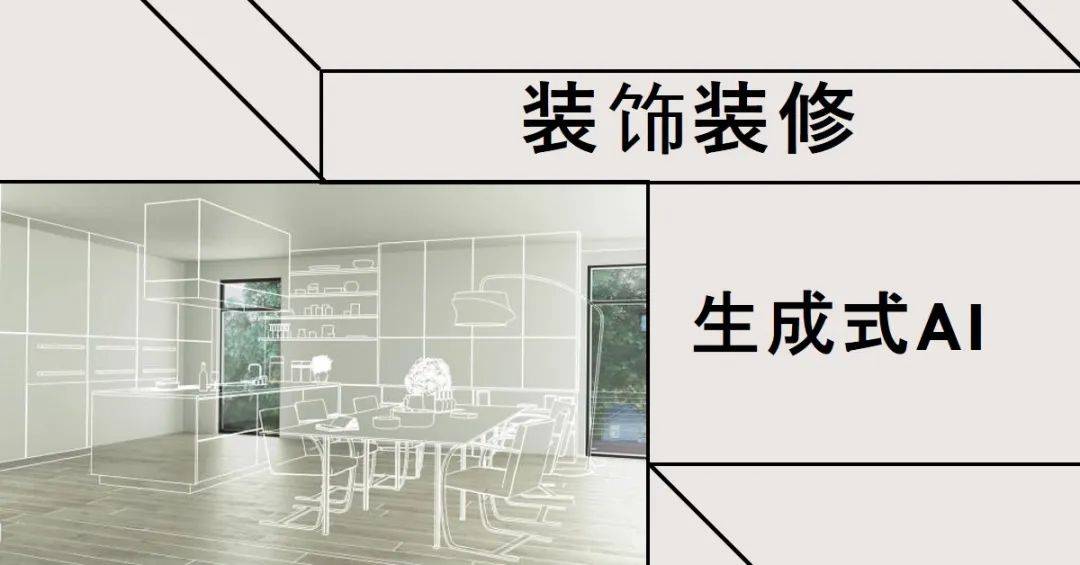
Through the above application scenarios and cases, we can see that the application of generative AI in the field of decoration can provide enterprises and individual users with more efficient, more flexible, and more personalized design options, improving user experience and satisfaction. Spend. Generative AI has huge potential in improving design efficiency, enriching design creativity, and meeting user needs.
What is certain is that with the continuous development and improvement of technology, generative AI will bring more possibilities and value to the decoration industry.
The future of generative AI in the field of decoration
Generative AI can help interior designers improve efficiency and creativity, and create space designs that are more in line with user needs and personalization. Generative AI can also provide interior designers with more inspiration and ideas, as well as better visual effects and user experience.
This means that it has extremely broad application prospects in the field of decoration design. Below are some future development trends of generative AI in the field of decoration and decoration summarized by Wang Jiwei’s channel.
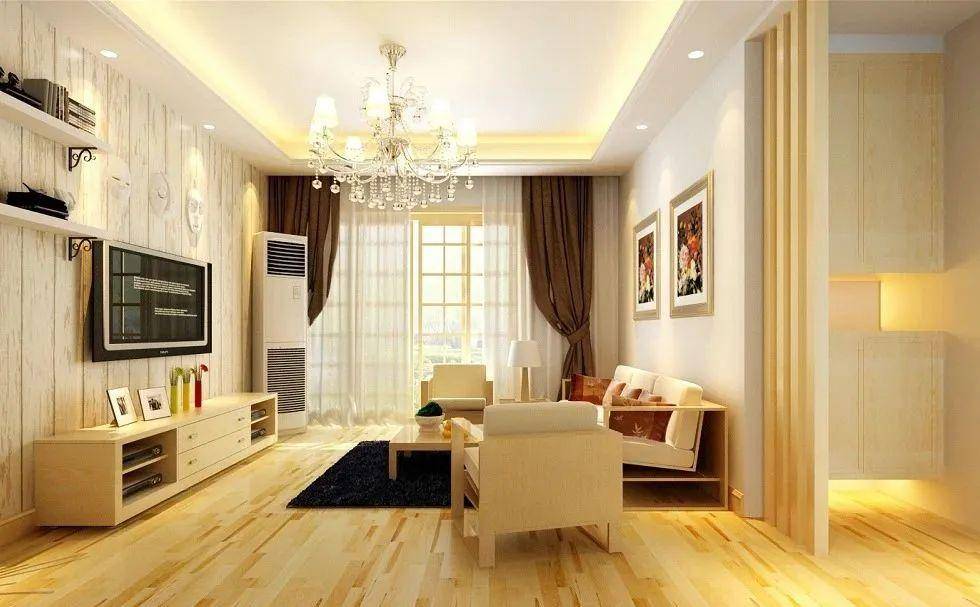
Trend 1: More precise user needs. Generative AI can use big data and machine learning algorithms to analyze users' preferences, styles and needs, and generate the best design solutions based on the information. For example, using DesignSpy can speed up the "furniture hunting" process. Just upload an inspiration photo and it will quickly identify all the furniture in the picture and find identical or similar versions.
Trend 2: More realistic design experience. Generative AI can combine augmented reality (AR) and virtual reality (VR) technologies to provide interior designers with a more realistic and immersive design experience. Interior designers can completely recreate a room or space in a 3D rendering and get a feel for the designed space without actually entering the space. Users can also preview and experience different design options through AR or VR devices to make better choices.
Trend 3: More creative ways of expression. Generative AI can create new and unique content such as images, music, and text, providing interior designers with more creative expressions. For example, generative AI can generate music or patterns that fit the atmosphere of a space based on the user's emotions or themes. Generative AI can also generate personalized content based on a user’s tastes or interests, such as news articles or music recommendations.
Trend 4: A more intelligent and comfortable environment. Generative AI can be combined with smart home systems to provide users with a smarter and more comfortable living environment. Generative AI can automatically adjust lighting, temperature, volume and other parameters in the space based on the user's behavior, habits and preferences. Generative AI can also be paired with smart furniture to provide users with more functionality and convenience.

It is conceivable that if the entire home decoration link in the future, from design to final purchase, is based on WYSIWYG interactive drawings based on generative AI, it will undoubtedly change the business operation model of the entire decoration industry chain, and will provide this bring disruptive impact to the field.
So, generative AI has broad application prospects in the field of decoration. With the continuous advancement and innovation of technology, it will bring us a more beautiful, smarter and more personalized indoor space.
Due to the influence of technical characteristics and other factors, any field that wants to introduce and apply generative AI will inevitably encounter risks and challenges, and the same is true for the decoration field.
Simply speaking, the challenges and risks encountered by generative AI in the field of decoration mainly include the following points:
Data security and copyright issues. Generative AI requires a large amount of data to train the model, which may involve customers' private information, such as address, family structure, living habits, etc. If data is leaked or misused, it may pose security risks to customers. On the other hand, the content or data generated by generative AI may infringe the copyright of the original author or designer, causing legal disputes or ethical disputes.
Quality and reliability issues. Although generative AI can quickly generate large amounts of content or data, it does not necessarily guarantee its quality and reliability. Some content or data may contain errors, defects or unreasonableness and require manual review and modification. In addition, generative AI may lack innovation and personalization, repeat or imitate existing content or data, and fail to meet customers' unique needs and aesthetics.

Human-computer interaction and communication issues. There may be barriers or misunderstandings in the interaction and communication between generative AI and clients or designers. Generative AI may not be able to accurately understand the intentions, needs, and preferences of customers or designers, or be unable to clearly express its ideas, suggestions, and feedback. This can lead to ineffective communication and even conflict or dissatisfaction.
Ethical and social issues. The application of generative AI in the field of interior decoration may have an impact on human creativity, career, culture and values. Some people may worry that generative AI will replace human creativity and work, leading to unemployment or career crises. Others may worry that generative AI will destroy human cultural diversity and individual expression, leading to homogeneity or distortion.
Postscript: Using generative AI to enhance decorative design
The unemployment problem was mentioned above among the ethical and social issues brought about by the application of generative AI in the field of decoration. At present, this may also be what worries China's 3 million home decoration designers the most.
Interior AI wrote this sentence in the most eye-catching position on the official website: Fire your interior designer, Design your own interior with the first AI Interior Designer.
This sentence translated means: Fire your interior designer and use the first AI designer to complete your interior design.
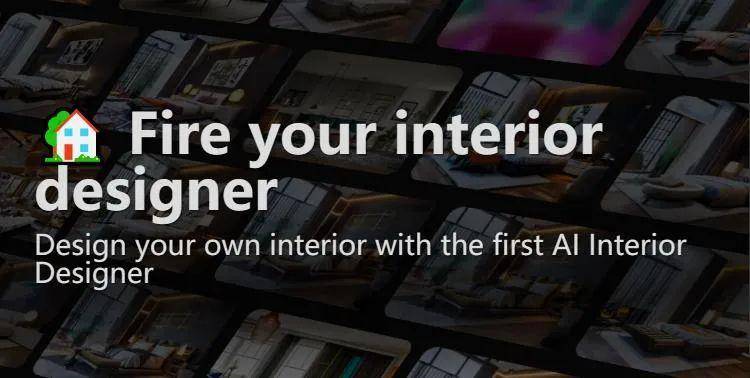
Obviously, this is not only for individual users, but also for the majority of decoration companies. It is conceivable that many companies may use generative AI to produce pictures in the future. The drawing process is getting simpler and simpler. A decoration company only retains experienced senior designers for coordination and guidance, plus a few AI draftsmen. It is estimated that there is no need for ordinary designers.
Wang Jiwei Channel (id:jiwei1122) believes that in fact, everyone does not need to be so anxious. Generative AI does allow ordinary people to easily generate decoration renderings, but to a certain extent it liberates designers. You must know that drawings for customers are now free of charge. Customers can create the desired renderings by themselves, and designers enjoy the results.
At the same time, designers can also use these generative AI tools to quickly generate renderings, as is done by designer bloggers such as Douyin and Xiaohongshu.

At least for now, generative AI cannot completely replace the role of human designers. It can only be used as an auxiliary tool and cannot replace the professional knowledge, creative thinking and aesthetic perspective of human designers.
You must know that all tools serve human beings. Now that AIGC is here, it is natural to actively embrace tools that can improve productivity.
For designers, why not use AI to enhance their abilities, free up their time and achieve more results?
Attachment: 25 generative AI applications for decoration
1. Interior AI: Interior design AI, just upload indoor photos and help you generate interior renderings of various design styles.
Experience address: https://interiorai.com
2. GetFloorPlan: Convert 2D building plans into 3D entities, upload interior design plan manuscripts, automatically generate renderings for you, and create 2D, 3D floor plans and 360° virtual tours.
Experience address: https://getfloorplan.com
3. RoomGPT: helps you design a variety of decoration plans and turn your ideas into renderings.
Experience address: https://www.roomgpt.io
4. Maket: Revolutionize design with generative AI - Maket enables architects, designers, builders, contractors and developers to generate floor plans, browse zoning codes and explore unlimited styles.
Experience address: https://www.maket.ai
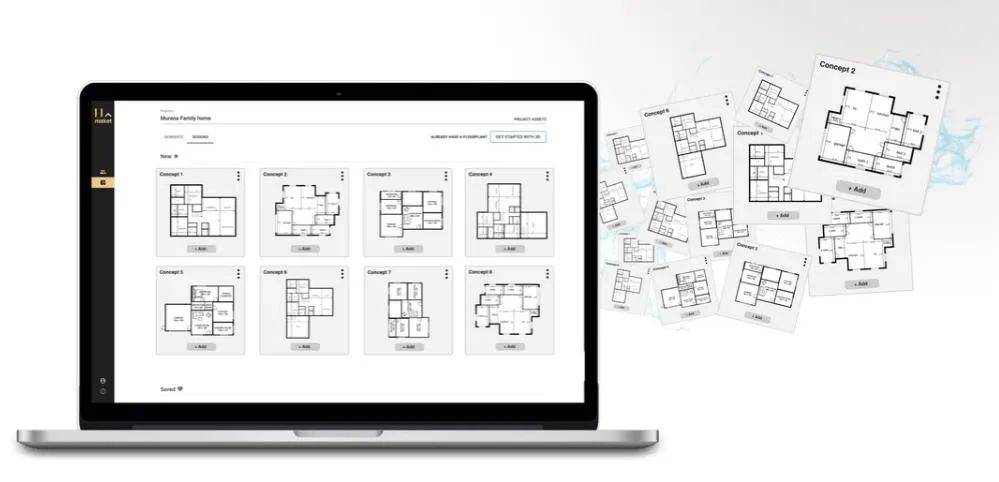
5. REimagine: Reimagine any space by evaluating architectural elements, detecting room types, understanding preferred design styles, and adhering to your color preferences and text instructions.
Experience address:
https://www.reimaginehome.ai
6. arko.ai: Architectural sketches are rendered and colored, cloud-based AI generates renderings, and the rendering process can be reimagined with the click of a button.
Experience address: https://arko.ai
7. Collov: Interior design AI, upload indoor pictures and automatically design a variety of decoration effects for you.
Experience address: https://collov.com
8. Craftle: Home design AI can generate multiple design styles of combined furniture and soft decoration design effects.
Experience address: https://craftle.app
9. Planner5d: Interior design tool, freely choose your plan and help you generate design renderings.
Experience address: https://planner5d.com
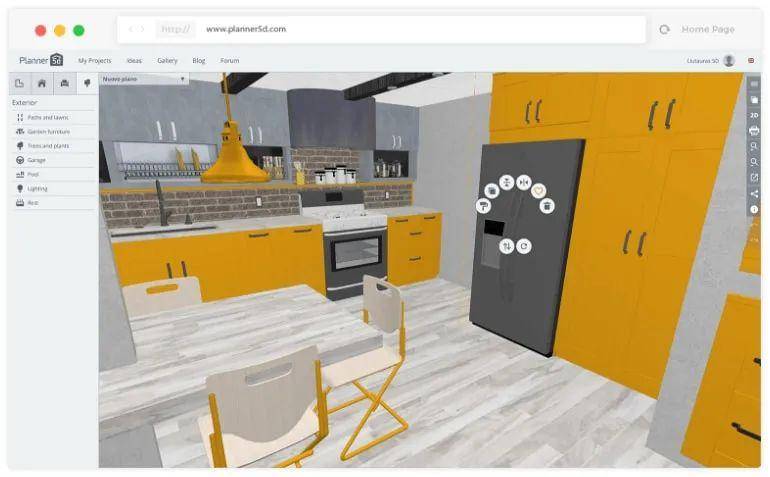
10. Ai room planner: Generate design pictures of different styles through existing interior decoration, and get hundreds of interior design ideas for your room for free.
Experience address: https://airoomplanner.com
11. Kujiale Mubao Cloud AI architectural creation: Use SD to create online for pan-architectural scenes (architecture, interior, landscape) without high configuration and deployment, and use SD to produce pictures online for free (Unlimited), train lora for free.
Experience address: https://app.modaiyun.com
12. AlphaDraw: A new generation of intelligent design platform for the field of construction engineering. Embed a knowledge base containing industry standard data, specification requirements, engineering experience and common practices, and use it with a powerful construction drawing drawing intelligent algorithm to achieve 10 times improvement in drawing efficiency. Supports cloud design operations and multi-person collaborative work, enabling project teams to collaborate efficiently based on the same model.
Experience address:
https://www.pinlandata.com
13. PromeAI: can directly convert graffiti and photos into illustrations, automatically recognize character poses and generate illustrations; convert line drawings into complete colored drawings, and provide a variety of color schemes; Automatically identify image depth information to generate images with the same depth of field structure, identify line segments in architectural and interior images and generate new design solutions;
Experience address: https://www.promeai.com

14. Dreamhouseai: Provides quick interior design for your home space, 35 styles of interior design ideas and models for any space.
Experience address: https://dreamhouseai.com
15. Skybox: Import 2D surround image and generate 360 holographic scene.
Experience address:
https://skybox.blockadelabs.com
16. Architechtures: An AI-driven architectural design web tool for the residential sector that helps you improve decision-making and reduce design time from months to minutes.
Experience address:
https://architechtures.com/en/enterprise-contact
17. Interior Computer: Use AI to reimagine your interiors.
Experience address: https://image.computer
18. Fabrie AI: An AI-driven design tool built on Fabrie whiteboard. It helps industrial designers, fashion designers, and interior designers quickly generate photorealistic renderings with sketches in seconds. During the testing phase, designers can register and try it out.
Experience address: https://www.fabrie.com

19. Decorous: AI Home Makeovers: The ultimate tool for interior design enthusiasts, you can create your dream home in just a few taps.
https://apps.apple.com/us/app/decorous-ai-home-makeovers
20. DecorAI: Indoor creativity in seconds.
Experience address: https://decorai.io
21. Mobel: Create custom interior design variations and transform your rooms using artificial intelligence.
Experience address: https://mobel.app
22. Oda Studio: Choose your style and colors and use AI to customize your home in seconds.
Experience address:
https://moodboard.odastudio.ai
23. Spacely AI: Make your dream space a reality.
Experience address: https://www.spacely.ai/
24. DreamStaging AI: AI-driven virtual decoration solution, upload a photo of an empty room and get dozens of professionally designed and furnished interior changes in minutes, covering a variety of Style and room type.
Experience address: https://dreamstaging.ai

25. Pipers: Create stunning interior design concepts in seconds.
Experience address: https://www.pipers.ai
26. AITwo: An artificial intelligence-driven design tool that can be used to design the interior design of rooms such as bedrooms, living rooms, kitchens, bathrooms, and dining rooms. It can also be used to design the exterior of homes and buildings.
Experience address: https://aitwo.co
27. HALFWORK: can be used to write articles, write scripts, learn English, write code, draw, write documents, or create your own work scenes, including decoration drawings.
Experience address: https://halfwork.cn
28. Chenyu AI: Allow designers to create and render faster than ever by procuring hand-drawn sketches or a combination of su and AI processing tools.
Experience address: https://www.cyuai.com
Full text ends
[Wang Jiwei Channel, focusing on AIGC and IoT, focusing on digital transformation, business process automation and RPA, welcome to follow and communicate. 】
The above is the detailed content of Say goodbye to design software to generate renderings in one sentence, generative AI subverts the field of decoration and decoration, with 28 popular tools. For more information, please follow other related articles on the PHP Chinese website!

Hot AI Tools

Undresser.AI Undress
AI-powered app for creating realistic nude photos

AI Clothes Remover
Online AI tool for removing clothes from photos.

Undress AI Tool
Undress images for free

Clothoff.io
AI clothes remover

AI Hentai Generator
Generate AI Hentai for free.

Hot Article

Hot Tools

Notepad++7.3.1
Easy-to-use and free code editor

SublimeText3 Chinese version
Chinese version, very easy to use

Zend Studio 13.0.1
Powerful PHP integrated development environment

Dreamweaver CS6
Visual web development tools

SublimeText3 Mac version
God-level code editing software (SublimeText3)

Hot Topics
 1376
1376
 52
52
 Chinese mathematician Terence Tao leads the White House Generative AI Working Group, and Li Feifei will speak at the group
May 25, 2023 am 10:36 AM
Chinese mathematician Terence Tao leads the White House Generative AI Working Group, and Li Feifei will speak at the group
May 25, 2023 am 10:36 AM
The Generative AI Working Group established by the President's Council of Advisors on Science and Technology is designed to help assess key opportunities and risks in the field of artificial intelligence and provide advice to the President on ensuring that these technologies are developed and deployed as fairly, safely, and responsibly as possible. AMD CEO Lisa Su and Google Cloud Chief Information Security Officer Phil Venables are also members of the working group. Chinese-American mathematician and Fields Medal winner Terence Tao. On May 13, local time, Chinese-American mathematician and Fields Medal winner Terence Tao announced that he and physicist Laura Greene will co-lead the Generative Artificial Intelligence Working Group of the U.S. Presidential Council of Advisors on Science and Technology (PCAST) .
 From 'human + RPA' to 'human + generative AI + RPA', how does LLM affect RPA human-computer interaction?
Jun 05, 2023 pm 12:30 PM
From 'human + RPA' to 'human + generative AI + RPA', how does LLM affect RPA human-computer interaction?
Jun 05, 2023 pm 12:30 PM
Image source@visualchinesewen|Wang Jiwei From "human + RPA" to "human + generative AI + RPA", how does LLM affect RPA human-computer interaction? From another perspective, how does LLM affect RPA from the perspective of human-computer interaction? RPA, which affects human-computer interaction in program development and process automation, will now also be changed by LLM? How does LLM affect human-computer interaction? How does generative AI change RPA human-computer interaction? Learn more about it in one article: The era of large models is coming, and generative AI based on LLM is rapidly transforming RPA human-computer interaction; generative AI redefines human-computer interaction, and LLM is affecting the changes in RPA software architecture. If you ask what contribution RPA has to program development and automation, one of the answers is that it has changed human-computer interaction (HCI, h
 Why is generative AI sought after by various industries?
Mar 30, 2024 pm 07:36 PM
Why is generative AI sought after by various industries?
Mar 30, 2024 pm 07:36 PM
Generative AI is a type of human artificial intelligence technology that can generate various types of content, including text, images, audio and synthetic data. So what is artificial intelligence? What is the difference between artificial intelligence and machine learning? Artificial intelligence is the discipline, a branch of computer science, that studies the creation of intelligent agents, which are systems that can reason, learn, and perform actions autonomously. At its core, artificial intelligence is concerned with the theories and methods of building machines that think and act like humans. Within this discipline, machine learning ML is a field of artificial intelligence. It is a program or system that trains a model based on input data. The trained model can make useful predictions from new or unseen data derived from the unified data on which the model was trained.
 Say goodbye to design software to generate renderings in one sentence, generative AI subverts the field of decoration and decoration, with 28 popular tools
Jun 10, 2023 pm 03:33 PM
Say goodbye to design software to generate renderings in one sentence, generative AI subverts the field of decoration and decoration, with 28 popular tools
Jun 10, 2023 pm 03:33 PM
▲This picture was generated by AI. Kujiale, Sanweijia, Dongyi Risheng, etc. have already taken action. The decoration and decoration industry chain has introduced AIGC on a large scale. What are the applications of generative AI in the field of decoration and decoration? What impact does it have on designers? One article to understand and say goodbye to various design software to generate renderings in one sentence. Generative AI is subverting the field of decoration and decoration. Using artificial intelligence to enhance capabilities improves design efficiency. Generative AI is revolutionizing the decoration and decoration industry. What impact does generative AI have on the decoration and decoration industry? What are the future development trends? One article to understand how LLM is revolutionizing decoration and decoration. These 28 popular generative AI decoration design tools are worth trying. Article/Wang Jiwei In the field of decoration and decoration, there has been a lot of news related to AIGC recently. Collov launches generative AI-powered design tool Col
 Watch: What is the potential of applying generative AI to network automation?
Aug 17, 2023 pm 07:57 PM
Watch: What is the potential of applying generative AI to network automation?
Aug 17, 2023 pm 07:57 PM
Generative artificial intelligence (GenAI) is expected to become a compelling technology trend by 2023, bringing important applications to businesses and individuals, including education, according to a new report from market research firm Omdia. In the telecom space, use cases for GenAI are mainly focused on delivering personalized marketing content or supporting more sophisticated virtual assistants to enhance customer experience. Although the application of generative AI in network operations is not obvious, EnterpriseWeb has developed an interesting concept. Validation, demonstrating the potential of generative AI in the field, the capabilities and limitations of generative AI in network automation One of the early applications of generative AI in network operations was the use of interactive guidance to replace engineering manuals to help install network elements, from
 Which technology giant is behind Haier and Siemens' generative AI innovation?
Nov 21, 2023 am 09:02 AM
Which technology giant is behind Haier and Siemens' generative AI innovation?
Nov 21, 2023 am 09:02 AM
Gu Fan, General Manager of the Strategic Business Development Department of Amazon Cloud Technology Greater China In 2023, large language models and generative AI will "surge" in the global market, not only triggering "an overwhelming" follow-up in the AI and cloud computing industry, but also vigorously Attract manufacturing giants to join the industry. Haier Innovation Design Center created the country's first AIGC industrial design solution, which significantly shortened the design cycle and reduced conceptual design costs. It not only accelerated the overall conceptual design by 83%, but also increased the integrated rendering efficiency by about 90%, effectively solving Problems include high labor costs and low concept output and approval efficiency in the design stage. Siemens China's intelligent knowledge base and intelligent conversational robot "Xiaoyu" based on its own model has natural language processing, knowledge base retrieval, and big language training through data
 Tencent Hunyuan upgrades model matrix, launching 256k long text model on the cloud
Jun 01, 2024 pm 01:46 PM
Tencent Hunyuan upgrades model matrix, launching 256k long text model on the cloud
Jun 01, 2024 pm 01:46 PM
The implementation of large models is accelerating, and "industrial practicality" has become a development consensus. On May 17, 2024, the Tencent Cloud Generative AI Industry Application Summit was held in Beijing, announcing a series of progress in large model development and application products. Tencent's Hunyuan large model capabilities continue to upgrade. Multiple versions of models hunyuan-pro, hunyuan-standard, and hunyuan-lite are open to the public through Tencent Cloud to meet the model needs of enterprise customers and developers in different scenarios, and to implement the most cost-effective model solutions. . Tencent Cloud releases three major tools: knowledge engine for large models, image creation engine, and video creation engine, creating a native tool chain for the era of large models, simplifying data access, model fine-tuning, and application development processes through PaaS services to help enterprises
 Transformative Trend: Generative Artificial Intelligence and Its Impact on Software Development
Feb 26, 2024 pm 10:28 PM
Transformative Trend: Generative Artificial Intelligence and Its Impact on Software Development
Feb 26, 2024 pm 10:28 PM
The rise of artificial intelligence is driving the rapid development of software development. This powerful technology has the potential to revolutionize the way we build software, with far-reaching impacts on every aspect of design, development, testing and deployment. For companies trying to enter the field of dynamic software development, the emergence of generative artificial intelligence technology provides them with unprecedented development opportunities. By incorporating this cutting-edge technology into their development processes, companies can significantly increase production efficiency, shorten product time to market, and launch high-quality software products that stand out in the fiercely competitive digital market. According to a McKinsey report, it is predicted that the generative artificial intelligence market size is expected to reach US$4.4 trillion by 2031. This forecast not only reflects a trend, but also shows the technology and business landscape.



